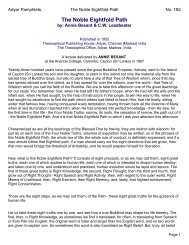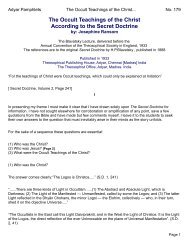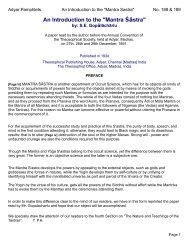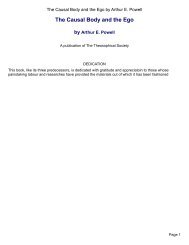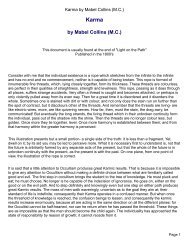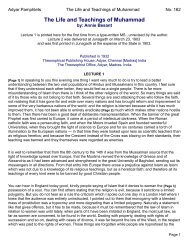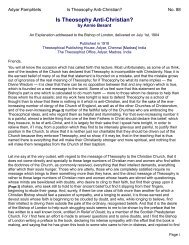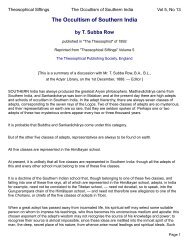The Theosophical Seal - Canadian Theosophical Association
The Theosophical Seal - Canadian Theosophical Association
The Theosophical Seal - Canadian Theosophical Association
Create successful ePaper yourself
Turn your PDF publications into a flip-book with our unique Google optimized e-Paper software.
<strong>The</strong> <strong>The</strong>osophical <strong>Seal</strong> by Arthur M. Coon<br />
so called from the fact that each arm is divided at the end into three pointed segments resembling the<br />
petals of a flower. This Cross refers especially to the Third Logos (in Christian nomenclature the Holy<br />
Ghost or the Third Person) and represents the threefold power of Spirit flowing out into a fourfold<br />
universe. This particular cross is most commonly found embroidered upon tapestries and ecclesiastical<br />
vestments, carvings upon church furniture, interior and window decorations and over cathedral doors.<br />
This form of the cross calls to mind its universal- that is, catholic or cosmic- significance. Other forms of<br />
the cross are the Swastika (d) and the Tau (e), each of which carries a message distinctively its own; and<br />
since each of these crosses forms an integral part of the <strong>The</strong>osophical <strong>Seal</strong>, they will be the subject of<br />
special studies. <strong>The</strong> form of the cross with which the Christian world is most familiar is the Latin Cross (f)<br />
in which the lower section is twice the length of the upper section or the arms.<br />
A RELIGIOUS SYMBOL<br />
<strong>The</strong> Cross, in the minds of most of us, is associated with the Christian religion. Nevertheless history has<br />
proven that it was not originally a Christian symbol. Carvings upon rocks and walls of caves are evidence<br />
that as a religious symbol it is vastly older than Christianity. We may correctly assume therefore that<br />
Christianity appropriated the cross and made it her own particular symbol. That is to say,the idea of the<br />
Cross as a Christian symbol of hope and victory had its origins ages before the crucifixion of Jesus. We<br />
say this, not in any sense of irreverence,but with a deep conviction that due to the essential nature of the<br />
cross,the death of the Christos, following the pattern of the Divine Sacrifice throughout all ages, could<br />
only have taken place upon a cross.<br />
For Christianity was given to mankind as the latest in the line of mystery religions, a fact lost sigh of after<br />
the disappearance of the Gnosis. Like all mystery religions,she veiled her truths under the guide of<br />
allegory and symbol. That men have mistaken the symbol for the reality is the greatest tragedy of the<br />
age. We may truly say that Christianity dramatised, historically in the life of Jesus, and continuously<br />
through her rituals, the great cosmic or universal truths which are embodied in the symbol of the Cross.<br />
For the critic to deny the historic reality of the Christian drama and its "dramatic personae" because he<br />
learns that it fits into the mould of a universal or cosmic pattern is as illogical as it would be for the<br />
scientist, beholding in the atom under his microscope a miniature solar universe, to deny the existence of<br />
that atom on the grounds that it "copies" the larger pattern. Indeed, of no other religion upon our planet,<br />
at least in the memory of man, can it be said that it presents its philosophy and its theology (I use this<br />
word in a universal sense) in the pattern of a divine or sacred drama - a pattern which loses nothing of<br />
truth or uniqueness because it is a replica (in time) of that drama of creation whereby worlds and all living<br />
Page 36



